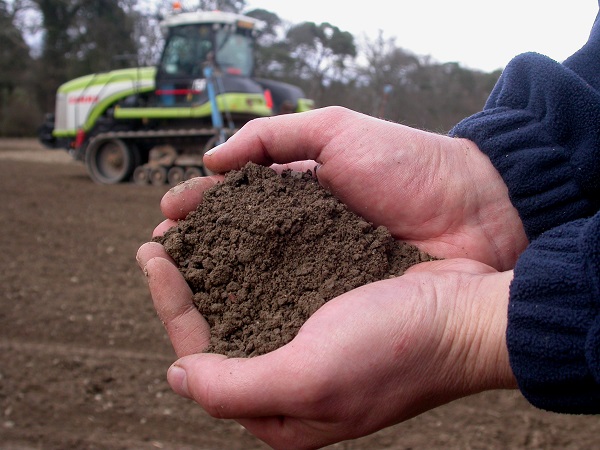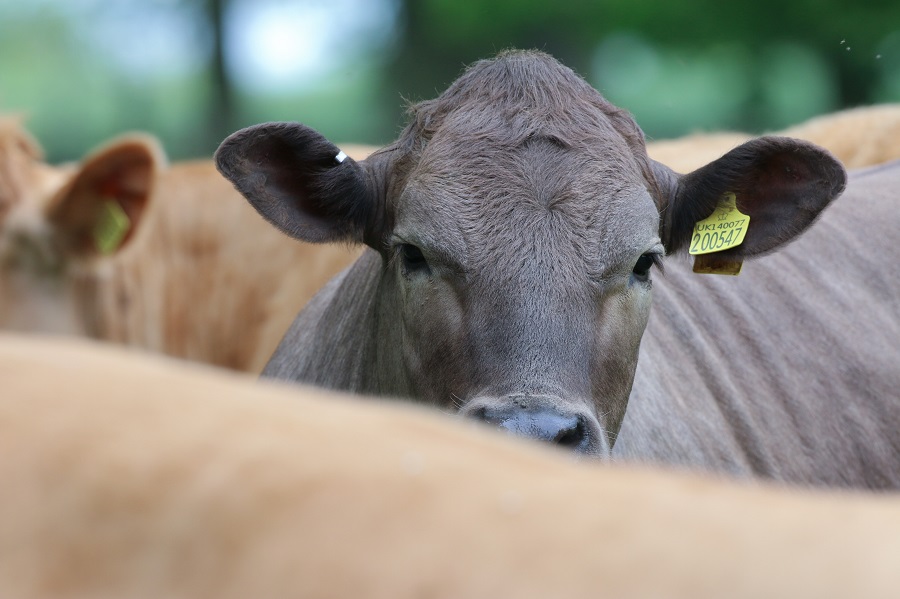Over the past few decades farms have become increasingly specialised, with arable growers losing many of the traditional benefits of a mixed rotation. CPM gets an insight into how livestock farmers and arable growers can work together for mutual gain.
Combining the two systems has a positive benefit from a climate change perspective.
By Lucy de la Pasture
Most arable farms had a mix of enterprises a couple of generations ago, but the livestock have long since disappeared and with it the benefits they brought to the rotation. But grass leys are slowly creeping back into the arable rotation, partly to help with blackgrass control but also because it plays a key role in enhancing soil health.
The reintroduction of grass leys can also bring other opportunities, including synergistic arrangements between arable and livestock farmers providing an income stream for one and land for the other.

Trampled plant material and manure return organic matter to the soil when mob-grazing beef.
Last year, AHDB published it’s ‘Livestock and the arable rotation’ guide which explores how farmers can work together for mutual benefit. The guide covers the extensive opportunities available – including the grazing of arable land, growing crops for silage or hay and arranging muck-for-straw deals.
AHDB Lamb and Beef has looked more closely at the benefits of bringing grass back into the arable rotation and grazing beef by bringing together farmers from the two different sectors, explains AHDB beef scientist, Rebecca Small.
“The arrangement effectively enables the intensive arable enterprise to adopt ‘mixed farming’ without investing in cattle and the beef enterprise to expand without investing in land,” she explains.
As well as the tangible benefits of soil improvement and blackgrass reduction from the introduction of leys and livestock into the arable rotation there are also possible longer-term benefits from the cross-sector approach.
“Combining the two systems has a positive benefit from a climate change perspective by achieving a better utilisation of land, as well as the other plus points,” she adds.
ADAS soil scientist Lizzie Sagoo has been leading the AHDB project and she believes that diversifying the arable rotation with grass leys brings potential benefits to the following arable crop.
“The inclusion of grass leys and grazing livestock helps improve some of the key components of soil health, including structure and soil organic matter (SOM) content. The combination of the lack of tillage, the leaf and root structure of the crop and the return of muck from the livestock all help to build SOM,” she explains.
But soil health isn’t the only winner from introducing livestock back into the arable rotation. “As well as an additional income stream, the grass ley can also aid blackgrass management and bring a yield benefit when the land returns to arable cropping,” she says.
The AHDB project started in 2016 at Thriplow Farms in Cambs with a herbal ley which had already been down for two seasons. “It provided a good opportunity to look at beef performance together with the economics and quality of forage production. But as it was already the third year of the ley, we didn’t have the opportunity to look at the effects on soil health,” explains Lizzie.
So a second site was incorporated into the project in 2017, with a three-year grass ley sown in Somerset. “We made baseline assessments for soil quality characteristics, organic matter and soil biology before the ley was established. We’ll repeat this in 2021 before the crop returns to arable so that we can characterise the improvements to soil quality.”
The project is split into three treatments with cattle grazed across three fields. The first is split equally between a grass/clover mix and arable cropping so that the impact on blackgrass in the following arable crop can be assessed. The other two fields are split between a grass/clover mix and a herbal grass/clover mix and beef performance will be measured to assess the effects of the different forage regimes.
Blackgrass populations have also been assessed in the arable crop prior to the grass ley being sown, confirms ADAS weed scientist Lynn Tatnell. “We took blackgrass head counts in the summer of 2017 and mapped the areas of infestation so that we’ll be able to characterise the effect the grass ley has had on managing the population,” she explains.
Lynn believes the project will demonstrate how an integrated approach to grassweed management over a long rotation can contribute to control of populations. “The Cambs site has seen a benefit from the introduction of a three-year grass ley into the rotation and has noticed the effect of the seedbank decline on the blackgrass population.”
One of the issues which will be addressed in the project is the potential for grass and herbal plants to become weeds in the arable rotation, she explains. “At Thriplow there was a lot of chicory in the mix which was evident as a weed in the subsequent arable crop but was easy to control.”
Running in parallel to the AHDB project is a grass and herbal leys farm network, where ADAS work directly with farmers. “The idea was to work with farmers to create a bigger data set in order to gain a more meaningful insight on the effects of grass and herbal leys on soil quality and help us understand other rotational benefits of grass leys,” explains Lizzie.
“AHDB is looking at everything on this one site in Somerset but cost is a big barrier to collecting data from similar sites to gather a broader set of data. By working directly with growers and taking soil assessments before and after three-year leys, we hope to be able to gather soil quality data from a network of sites at a much lower cost.”
The network, which was launched by ADAS, AHDB and Defra in Feb 2018, is a partnership between farmers, researchers and industry. The initiative has already gathered some interesting data from an online survey which gives an insight into why farmers are interested in joining.
“We sent out a questionnaire because we wanted to understand the farming systems and identify any existing knowledge gaps,” says Lizzie.
Of the respondents, 46% were farmers and approx three quarters of them already had leys in the rotation, either as part of a mixed farming system or for beef/lamb production.
“The majority of people interested in becoming a part of the research network were interested in soil quality benefits, closely followed by farm resilience/sustainability,” she says. “Around half of the respondents said that leys had helped them in the management of blackgrass”
One of the most interesting findings was the tillage regimes used when returning the leys back into the arable rotation, highlights Lizzie. “I was surprised at the numbers using min (28%) or no till (26%) techniques. From a soil quality point of view it’s may be a case of two steps forward and one step back for soil quality if you plough after a grass ley, which is still the most widespread method (44%) in our survey.
“By minimising the soil movement you preserve the soil quality benefits from the grass ley for a longer period. It’ll be really interesting to characterise the longer-term soil quality benefits under these different tillage systems in the farm network,” she comments.
From a blackgrass control point of view, using the plough to establish the following arable crop is also not the wisest course of action, adds Lynn. “The worst thing to do is to turn up all the blackgrass seed that has lain dormant in the soil. But min and no tillage systems are very dependent on the use of glyphosate so there’s a huge interest from growers as to how best to establish a following crop if glyphosate is not available. The network will provide a valuable resource to answering many of these questions.”
Nuffield scholars find common ground
Farmer, vet and management consultant Rob Drysdale met Cambridgeshire arable farmer David Walston during his Nuffield Scholarship.
“I was looking at integration of the beef supply chain, improving the carbon footprint and efficiency of beef production and David was researching soils and how to improve them. One of the conclusions he reached was that UK soils needed more livestock,” Rob explains.
David had taken some land out of arable production and planted a herbal grass ley to help reduce the blackgrass population. He was using an intensive rotational system known as mob grazing where high numbers of animals graze an area of grass for a short time (usually a day) and the grass is given a prolonged period to recover (40-100 days). The idea is to let the plant grow much taller, with more biomass allowed to encourage root growth below ground.
When David decided to sell his own beef cattle, Rob stepped in and provided cattle to graze the herbal leys over two summers. “We set out on the basis that there had to be a benefit to both farmers. The aim was to produce an income as good as a second wheat for David and achieve liveweight gains in the region of 1.0 kg/day with the beef,” explains Rob.
“We learnt a few lessons in the process. In the second summer we had a lot of young cattle and they only achieved liveweight gains of 0.55kg/day which is below target. If I were to do it again then I’d employ someone locally to manage the cattle on a daily basis. Arable growers are often a generation removed from any level of stockmanship and all the paperwork now involved,” he adds.
One of the beauties of the beef grazing system used is that the infrastructure is all portable, with electric fencing and mobile water troughs. “Arable fields tend to be fairly square in shape which makes electric fencing much easier. Setting up the infrastructure does take some thought but it’s not difficult.”
The economic cost benefit analysis carried out as part of the AHDB project at Thriplow showed there is potential to make a margin from grazing cattle from an arrangement like the one between David and Rob.
David believes that it’s still too early to quantify the benefit of the grazing beef to the arable rotation, however his soil organic matter levels have increased from 3% to 4.5% over the three-year period.
This flying system of grazing beef also offers an opportunity for arable farmers to earn some extra income once the cattle have been taken away, suggests Rob. “Grazing with sheep will take the grass back down to zero, whereas cattle are more selective with their grazing. At 50p per head per week for a couple of months over the winter, sheep can provide an additional income stream and still allow the grass to rest for three months of the year.”
Research roundup
AHDB Beef & Lamb Project No 61100013 ‘Sustainable beef systems on arable units’ runs from April 2016 until March 2020 is led by ADAS and aims to investigate the practical, economic, environmental and agronomic implications of integrating beef enterprises into arable systems.
The Grass and Herbal Leys Farm Network was set up in 2018 and aims to establish a network of farmers, researchers and industry organisations to provide a platform to facilitate impacts of long-term grass leys in the rotation. A second meeting of the network will be held in early 2020. To register with the network https://www.adas.uk/services/Grass-and-herbal-leys-farm-network
AHDB’s Livestock and the arable rotation guide can be found at ahdb.org.uk/livestock-and-the-arable-rotation




